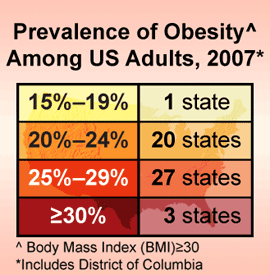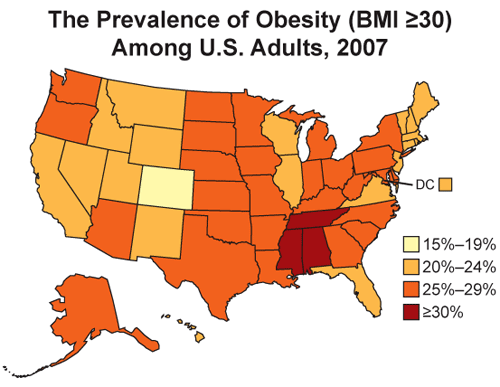Obesity in US Adults, BRFSS, 2007
No state met the Healthy People 2010 goal of 15% adult obesity

Obesity is a significant public health problem with serious implications for the health and well-being of the American public (1). The Healthy People 2010 (HP2010) national health objectives include one to reduce the proportion of adults who are obese to 15% (objective 19-2) (1). Obesity is defined as a body mass index (BMI) of 30 or above. BMI is calculated using height and weight. For example, a 5-foot, 9-inch adult who weighs 203 pounds would have a BMI of 30, thus putting this person into the obese category.
This analysis estimated the 2007 obesity prevalence among adults, by state, from self-reported weight and height data from the Behavioral Risk Factor Surveillance System (BRFSS). No state met the Healthy People 2010 objective of 15% and 30 states were 10 or more percentage points away from the objective. State-specific obesity prevalence ranged from 18.7% to 32.0%.
Among 2007 BRFSS respondents:
- 25.6% were obese.
- 26.4% of men and 24.8% of women were obese.
- The obesity prevalence ranged from 19.1% for men and women aged 18--29 years to 31.7% and 30.2%, respectively, for men and women aged 50--59 years.
- By race/ethnicity and sex the obesity prevalence was highest for non-Hispanic black women (39.0%) followed by non-Hispanic black men (32.1%).
- The obesity prevalence was higher in the South (27.3%) and Midwest (26.5%) and lower in the Northeast (24.4%) and West (23.1%).

| 2007 State Obesity Rates | |||||||
|---|---|---|---|---|---|---|---|
| State | % | State | % | State | % | State | % |
| Alabama | 30.3 | Illinois | 24.9 | Montana | 21.8 | Rhode Island | 21.4 |
| Alaska | 27.5 | Indiana | 26.8 | Nebraska | 26.0 | South Carolina | 28.4 |
| Arizona | 25.4 | Iowa | 26.9 | Nevada | 24.1 | South Dakota | 26.2 |
| Arkansas | 28.7 | Kansas | 26.9 | New Hampshire | 24.4 | Tennessee | 30.1 |
| California | 22.6 | Kentucky | 27.4 | New Jersey | 23.5 | Texas | 28.1 |
| Colorado | 18.7 | Louisiana | 29.8 | New Mexico | 24.0 | Utah | 21.8 |
| Connecticut | 21.2 | Maine | 24.8 | New York | 25.0 | Vermont | 21.3 |
| Delaware | 27.4 | Maryland | 25.4 | North Carolina | 28.0 | Virginia | 24.3 |
| Washington DC | 21.8 | Massachusetts | 21.3 | North Dakota | 26.5 | Washington | 25.3 |
| Florida | 23.6 | Michigan | 27.7 | Ohio | 27.5 | West Virginia | 29.5 |
| Georgia | 28.2 | Minnesota | 25.6 | Oklahoma | 28.1 | Wisconsin | 24.7 |
| Hawaii | 21.4 | Mississippi | 32.0 | Oregon | 25.5 | Wyoming | 23.7 |
| Idaho | 24.5 | Missouri | 27.5 | Pennsylvania | 27.1 | ||
CDC conducts obesity prevention programs and activities in many different settings and with a wide range of partners, including state and local health and education departments and communities across the country. For example, as part of CDC’s Nutrition and Physical Activity Program to Prevent Obesity and Other Chronic Diseases, the Washington State implemented a community intervention that promotes environmental and policy changes to help encourage healthful nutrition and physical activity behavior. Changes include widening sidewalks, connecting systems of paths for pedestrians and cyclists in a community, and creating community gardens.
CDC also works with employers and work-site health experts to translate evidence-based recommendations from the Task Force on Community Preventive Services (2) on work-site interventions for preventing obesity into business practice. One product from this collaboration will include a return on investment cost calculator to assist businesses in making the case for initiation and maintenance of wellness programs, especially those that promote weight management. In addition, an interactive website will provide guidance for the creation, expansion or customization of work-site obesity programs. These tools and products will enable employers to more easily implement the evidenced-based recommendations.
References:
1. US Department of Health and Human Services. Healthy People 2010 (conference ed, in 2 vols). Washington DC: US Department of Health and Human Services; 2000. Available at: http://www.health.gov/healthypeople.
2. CDC. Public health strategies for preventing and controlling overweight and obesity in school and worksite settings: a report on recommendations of the Task Force on Community Preventive Services. MMWR 2005;54(RR-10):1--12.
Data Source:
State-Specific Prevalence of Obesity Among Adults in the United States, 2007. MMWR, 2008;57(28):765-768.

